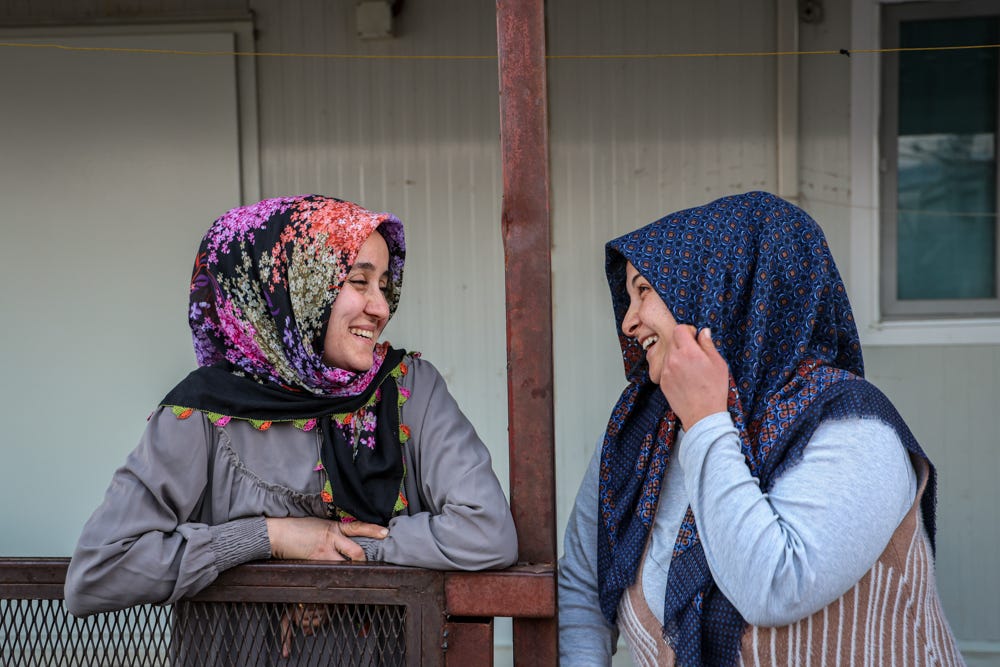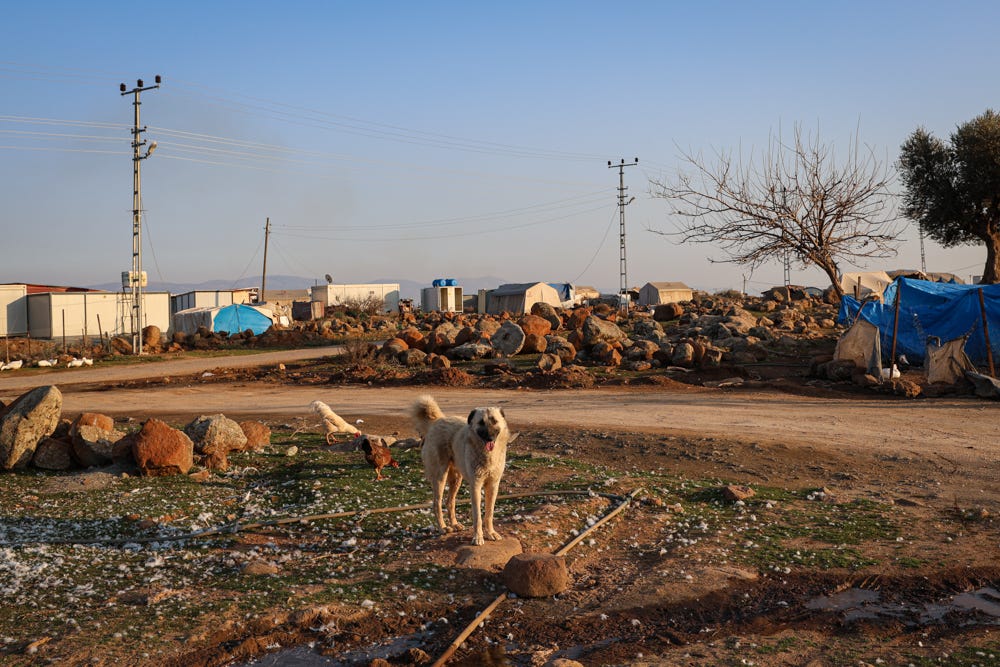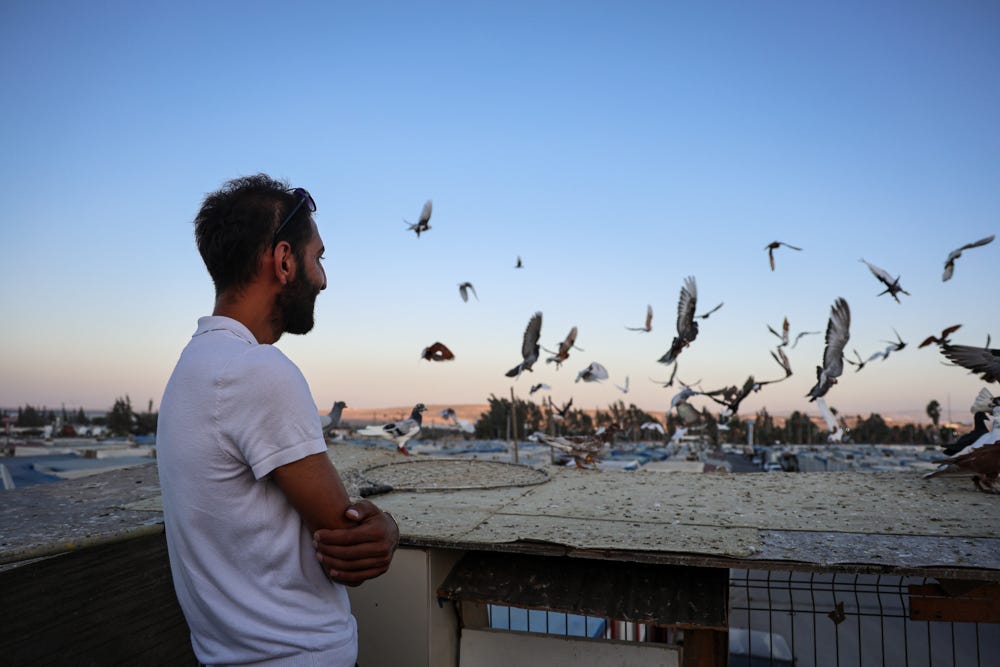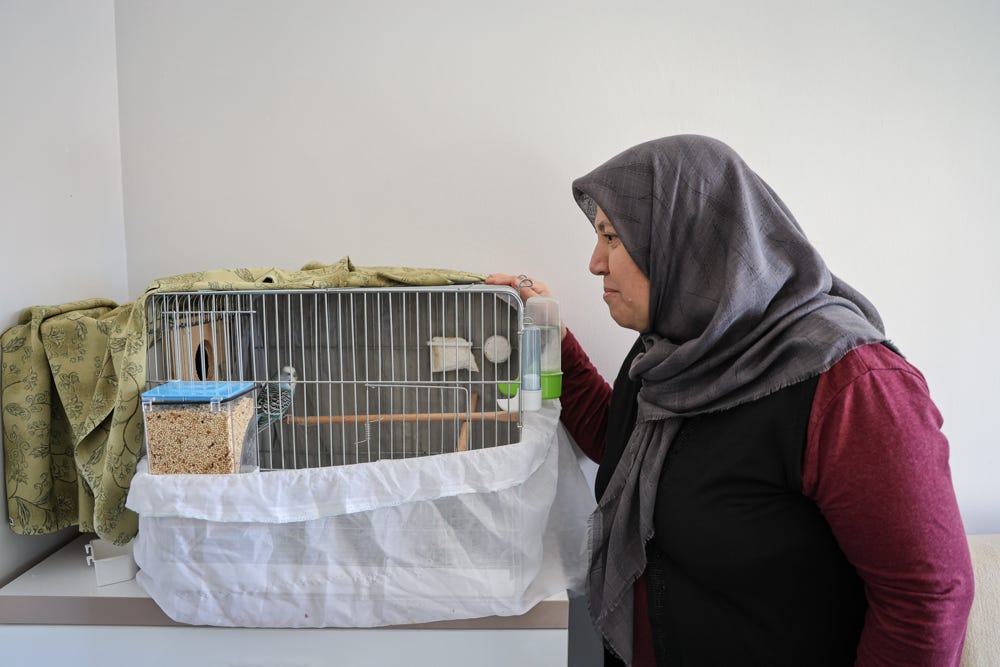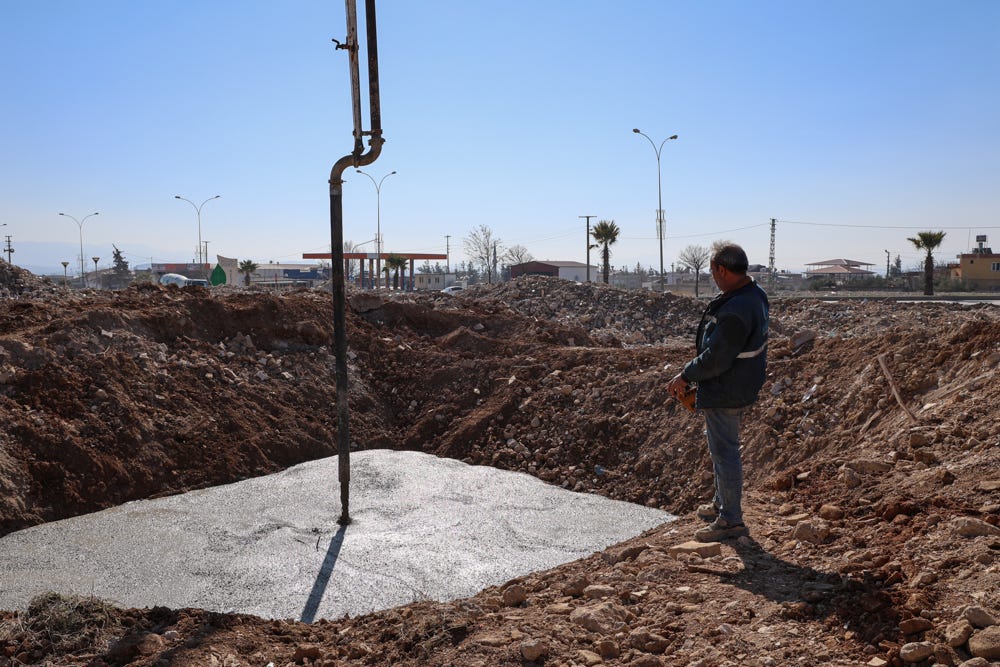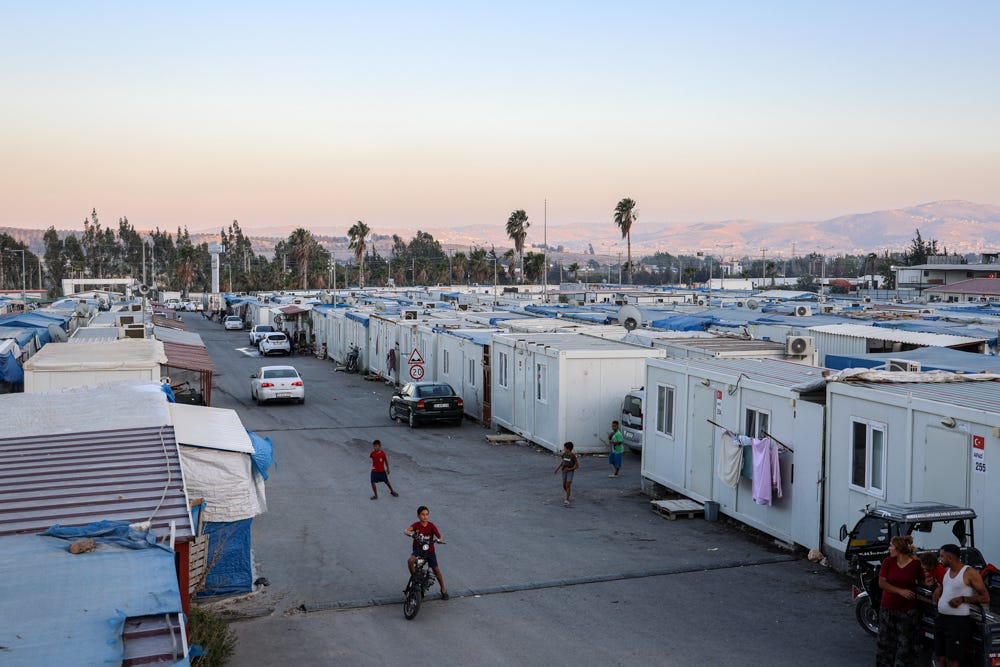
HATAY — Everyone from Guvenç, a village in the mountains of Turkey’s Hatay province, has been living in a container camp since the earthquakes on Feb. 6, 2023. About 500 people are housed here, in the nearby town of Hassa, where shelter and services are provided by Türkiye Petrolleri, the Turkish state oil company.
At the camp entrance, elderly women sit, drinking çay, while children play outdoors among wandering ducks, cows, dogs and chickens.
“It is important for us to continue living as we would in our village,” said Söngul, one of the women.
Inside the camp, older men rest in front of the containers and women – most of whom are under 30 – chat with their little kids in their arms.
Each container houses a family, on average about six people, in a 21 square-meter space. One of the camp’s containers serves as a mosque and children have transport services that take them to local schools.
Two and a half years after the earthquakes, residents of the affected areas are still waiting for answers and permanent housing. Though some appreciate the services provided in their camps, a feeling of abandonment is growing in some communities, such as the Dom.
The 2023 earthquakes left an estimated 3.3 million people homeless in Turkey and many of them await relocation as new housing projects are built throughout the nation’s south. To date, about 250,000 new homes have been completed in quake-hit provinces, according to the Presidency's Directorate of Communications, which also states the government aims to complete a total of 453,000 homes by the year-end.
Still, resettlement remains a challenge. Officials from the state’s Disaster and Emergency Management Authority (AFAD) told Turkey recap relocating families into permanent housing may take up to three years in Iskenderun and five years in Antakya, the city that saw the most extensive earthquake damage.
Allocating homes and flats
In the Hassa container camp, families have been waiting for months for an exact date to move to the new village of single-family homes that the government is building for them. They were all homeowners in the old village. For that reason, each family will receive a single-family home.
Those who lived in cities will receive a flat in the new apartment complexes built by TOKI, the state’s Housing Development Administration. In both cases, the government subsidizes 60 percent of the new accommodation and offers low-interest loans to pay for the other 40 percent.
The order of applications processed for new housing is based on the last digit of citizen’s identity documents. The size of the accommodation will be decided by lottery. In contrast, those who were tenants before the earthquakes will have to find new housing on their own.
The government told the residents of Guvenç their houses would be ready by Ramadan (in March) but they have not yet received their keys.
“We want to move into our new homes now,” said Esma Gedik, one of the residents. “All that is left to do is lay the paving tiles on the streets, but there is no one doing it.”
At the time of reporting, Guvenç residents were not aware of a new date for relocation. TOKI and the Hatay Governor’s office did not respond to multiple requests for comment for this report.
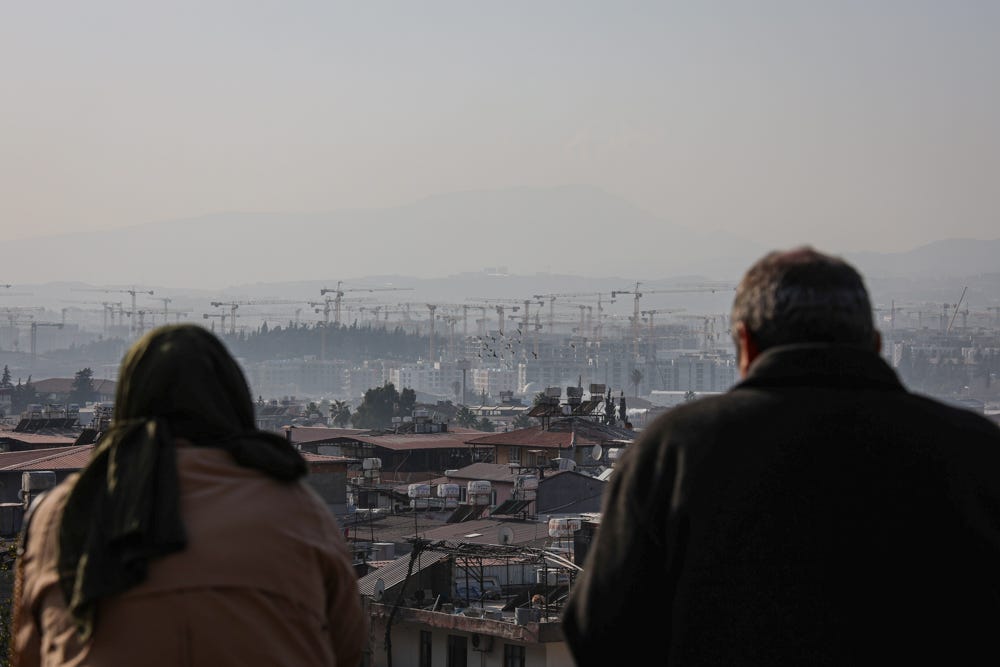
Camp conditions
Gedik also said the summer has not been difficult for her family, adding she is happy with the infrastructure and state services she has received in the camp to date.
“The situation is good and no one needs help because here you don't have to pay rent, water or electricity,” Gedik told Turkey recap.
Her opinion contrasts with that of the Hayata Destek association, which works to provide aid in various areas affected by earthquakes. Organization members claim that high temperatures – especially this summer – are affecting residents' health.
“The driest days in recent years are being experienced,” said Refik Karaçaylı, project manager of the Hatay program of Hayata Destek. “Rainfall during the 2024-2025 rainy season was sixty percent below seasonal norms.”
Karaçaylı added the Defne district of Hatay reached 48° C, making it one of the hottest regions in Turkey.
Usually, the camps are located in areas without shade or trees, meaning there is no shelter from the hot climate. This also causes temperatures inside the containers to rise.
“Although most containers in cities have air conditioning, they get so hot that, when they are not occupied, many of the objects inside are damaged by the high temperatures and can even pose a danger, such as overheated batteries or lighters,” said Rojda Dinç, the head of Hayata Destek’s Kahramanmaraş program.
Furthermore, water cuts implemented by the government in different parts of Turkey this summer have also complicated the situation.
“Frequent water cuts not only make daily life difficult, but also pose a risk to hygiene. The heat further exacerbates hygiene conditions,” said Hale Younso, leader of Hayata Destek’s program in Adıyaman.
These situations are even more serious for the most vulnerable communities, such as the elderly, children and people with disabilities, who are also present in the camps.
Unequal distribution of services
In Mehmet Kuyumcu’s camp, located between Iskenderun and Antakya, the problems are similar. He works for Sivil Düşler Derneği, a civil society organization, and noted in his visits to various camps that some have cafes, supermarkets, bookshops and other services – often provided by private companies.
In the AFAD-run camp where he lives, however, there aren't such amenities as the services in AFAD camps can vary widely. This summer, he said his camp went five days without running water and four days without electricity. He added he lost 15 kilos due to the heat and hunger is also an issue in the camp.
“People are starting to sell the materials from the containers because of poverty, so they can buy food for themselves,” Kuyumcu said, adding some people go to bed on an empty stomach.
He is part of the Dom community, like about 60 percent of the camp's inhabitants, most of whom are not eligible for new housing as they did not previously own property.
In Turkey, the Dom community is highly marginalized and some live semi-nomadic lifestyles, regularly migrating for seasonal work while facing challenges in accessing public education and health care.
Before the earthquake, part of Kuyumcu’s community lived on abandoned public land, and he said the lack of regulations has now led to even greater uncertainty.
“We have no idea what will happen when they take away the containers,” Kuyumcu told Turkey recap. “Because before the earthquake, the communities living here were already more vulnerable. In this process, we have no idea where exactly the solution will come from. They don't inform us. This will become a massive, large-scale problem.”

TOKI developments
Back in Hassa, some people have been living in the newly-built TOKI flats for over a year now. One of them is Feride, a local resident who moved into her new apartment in August 2024. Her new flat is 85 sqm, has three bedrooms and a living room.
Previously, her family had several properties, but she said the government only gives one unit per family. To build these cities, the government contracts the services to private construction companies from different parts of the country.
The new town in Hassa has the capacity for 40,000 inhabitants and is currently 90 percent occupied.
There are supermarkets, a school and a mosque as new workplaces remain under construction. However, Feride said several services are still missing.
“We still don't have a bazaar or anything like that. It would be better if we had one,” she told Turkey recap. “We also don't have a health center or a pharmacy, so we still have to go back and forth to the hospital.”
Rebuilding after disaster
The new Hassa is being built on vacant land in an area that the government has designated as safe. Though on private land in the affected cities, there are construction companies that are rebuilding in the same places where the buildings had collapsed.
This is the case of Ibrahim Karaoğlanoğlu Caddesi, one of the main avenues in Iskenderun. Mustafa Batuhan Güleç lived in a building on one of the plots on the avenue. On Feb. 6, 2023, 29 people in the building died and 11 survived. His body has not yet been found.
On the same site, a private company is now overseeing a construction project. Turkey recap spoke to two people supervising the site who said they are constructing safer buildings after the earthquakes.
To achieve this, they said they are injecting 20 meters of cement into the ground to stabilize the soil, which is weak due to its proximity to the sea. On top of this, they lay an iron grid, and instead of columns, they are using horizontal iron bars 20 cm wide and 2 meters long to support the structure.
Rebuilding in the same plots as collapsed buildings is a recurring practice in all affected areas.
Although the buildings may be constructed to higher standards, they may not always be safe, according to Dr. Pelin Pınar Giritlioğlu, a member of the Faculty of Architecture at Istanbul Technical University (ITÜ) and a former president of the Istanbul Chamber of Architects.
“In Adıyaman, once the earthquake was over, new plans were decided. They are the same as before,” Giritlioğlu told Turkey recap, stating city planning was not redesigned to accommodate rapid evacuation in the case of a future disaster.
“Once again, there is only one main road and new buildings. If there is another earthquake tomorrow, there will be the same consequences,” she added.
Critically, Giritlioğlu also said construction projects proceed with systematic shortcomings in government oversight, such as structural audits and follow-up inspections.
“When construction is complete and everything is done according to the project, the municipality issues a document certifying that the building is legal. But after that, they don't check it again,” she said.
“So what happens? They cut the column at the bottom. They expand the area. They create a soft ground. They remove the walls,” she warned. “And so, the building can become unsafe after receiving the residence document because the municipalities don't check it again.”
Turkey recap is an independent, reader-supported newsletter that helps people make sense of the fast-paced Turkey news cycle. Contact: info@turkeyrecap.com.
Subscribe here on Substack (or on Patreon for discount options). Paid subscribers get full access to our recaps, reports, members-only chat and news tracking tools.
Turkey recap is produced by our staff’s non-profit association, KMD. We are an affiliate of the Global Forum for Media Development and aim to create balanced news that strengthens local media by supporting journalists in Turkey.
Diego Cupolo, Editor-in-chief
Emily Rice Johnson, Deputy editor
Günsu Durak, Turkey recap Türkçe editor
Ceren Bayar, Parliament correspondent



